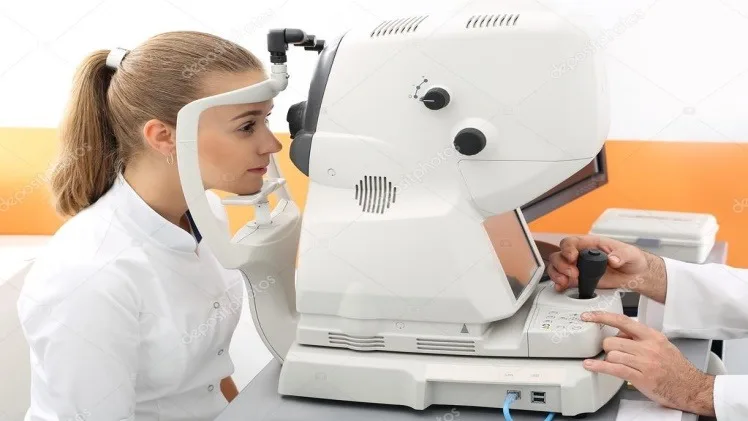As the medical software and equipment market expands, specialty-specific products continue to gain traction. Products like ophthalmology EHR systems aid in effective patient management, which is significant to the success of an ophthalmology facility.
Diagnostic Equipment
When you go for an eye examination, your eye doctor has to take an image of your eye and study it to determine if anything is wrong. Ophthalmologists use many types of imaging equipment to conduct eye exams. Below are some diagnostic imaging equipment you may find in your ophthalmologist’s facility:
Autorefractor
Ophthalmologists use an autorefractor to measure the eyes’ refractive error when prescribing eyeglasses and contact lenses. When you look into the machine, you see an image that goes in and out of focus. This device measures how light bends when it enters the eye based on how the image shows on the retina.
Retinal Camera
A retinal camera captures images of the retina. Ophthalmologists use this device to check how the retina changes over time and diagnose eye diseases.
VT 1 Vision Screener
This tool is a computerized tool used by ophthalmologists to diagnose vision problems and other eye conditions. The screener does not require pupil dilation to identify visual problems and works on patients of all ages. The VT 1 vision screener is portable and simple to use, which adds to its convenience.
Telemedicine Software
Telemedicine has gained popularity in recent years, and some ophthalmologists have adapted to their long-distance patients’ needs by investing in telemedicine software. The software allows ophthalmologists to evaluate and monitor patients remotely. Telemedicine software caters to the following healthcare service domains:
Live Video-audio Consultation
Doctors can have live sessions with patients to get information on their symptoms and answer their questions. Audiovisual telecommunication software is needed for this function.
Information Sharing
Information-sharing software facilitates the transmission of healthcare data. This includes symptom observations and possible diagnoses, which ophthalmologists use to evaluate patients further.
Remote Patient Monitoring
Remote patient monitoring (RPM) software allows doctors to collect health data from patients during their daily activities. An ophthalmologist can monitor a patient’s progress after eye surgery using their mobile device. They can ask them to answer a set of questions on a telehealth app regularly.
Ophthalmology EHR Systems
Ophthalmologists use EHR systems to manage patient information. Ophthalmology EHR systems are designed to meet the unique needs of ophthalmology clinics and often include specialist templates. These software platforms allow ophthalmologists to securely store, organize, and access patient records.
EHRs allow seamless information sharing and collaboration among care teams in ophthalmologist facilities. This improves the standard of care provided to patients. Below are some benefits of EHR systems:
Improved Efficiency
EHRs streamline administrative processes like appointment scheduling, billing, and coding, helping to reduce errors and improving overall efficiency. Doctors can focus on patient care rather than spending time on administrative tasks.
Comprehensive Patient Data
Ophthalmology EHR systems centralize patient details like medical history, diagnostic test results, prescriptions, and treatment plans. The systems allow doctors to access this information easily, facilitating faster and more informed decision-making.
Enhanced Patient Safety
EHR systems provide alerts for allergies, drug interactions, and potential complications, helping to promote patient safety. Ophthalmologists can track patients’ medications and monitor their treatment process based on the information recorded in the EHR system after every visit.
Improved Diagnostic Accuracy
Eye clinic EHRs may help improve the quality of diagnosis and treatment since they give doctors access to patients’ historical records. An ophthalmologist can learn which treatments a patient has previously received for their eye condition and recommend more effective treatments.
High-level Data Security
An EHR system allows admins to control who can access what type of data. Admins can add restrictions to only allow authorized parties to access sensitive information. EHRs also have security systems that prevent data loss and protect patients’ information fully, thus improving data security.
Surgical Equipment
Surgical equipment is a must-have for an eye clinic that performs surgical treatments. Below are some types of surgical equipment found in some ophthalmology clinics:
Phacoemulsification Machines
In cataract surgeries, ophthalmologists use a phacoemulsification machine to break and extract the clouded lens from patients’ eyes. This machine offers precise control, helping to reduce the time spent in surgery.
Excimer Lasers
Eye doctors use excimer lasers in eye surgeries like LASIK, which correct refractive conditions like myopia, hypermetropia, and astigmatism. The lasers provide exceptional accuracy, potentially minimizing surgical errors like overcorrection of refractive conditions.
Ophthalmologists Use the Best Technology
Effective patient management and healthcare service provision are key to the growth of medical practices. Software solutions like ophthalmology EHRs make it easier for doctors to manage their patients and streamline facility processes. Diagnostic imaging tools and surgical equipment make it possible for ophthalmologists to give their patients the best possible care. Look for ophthalmology practices that use the highest quality tools and technology.


